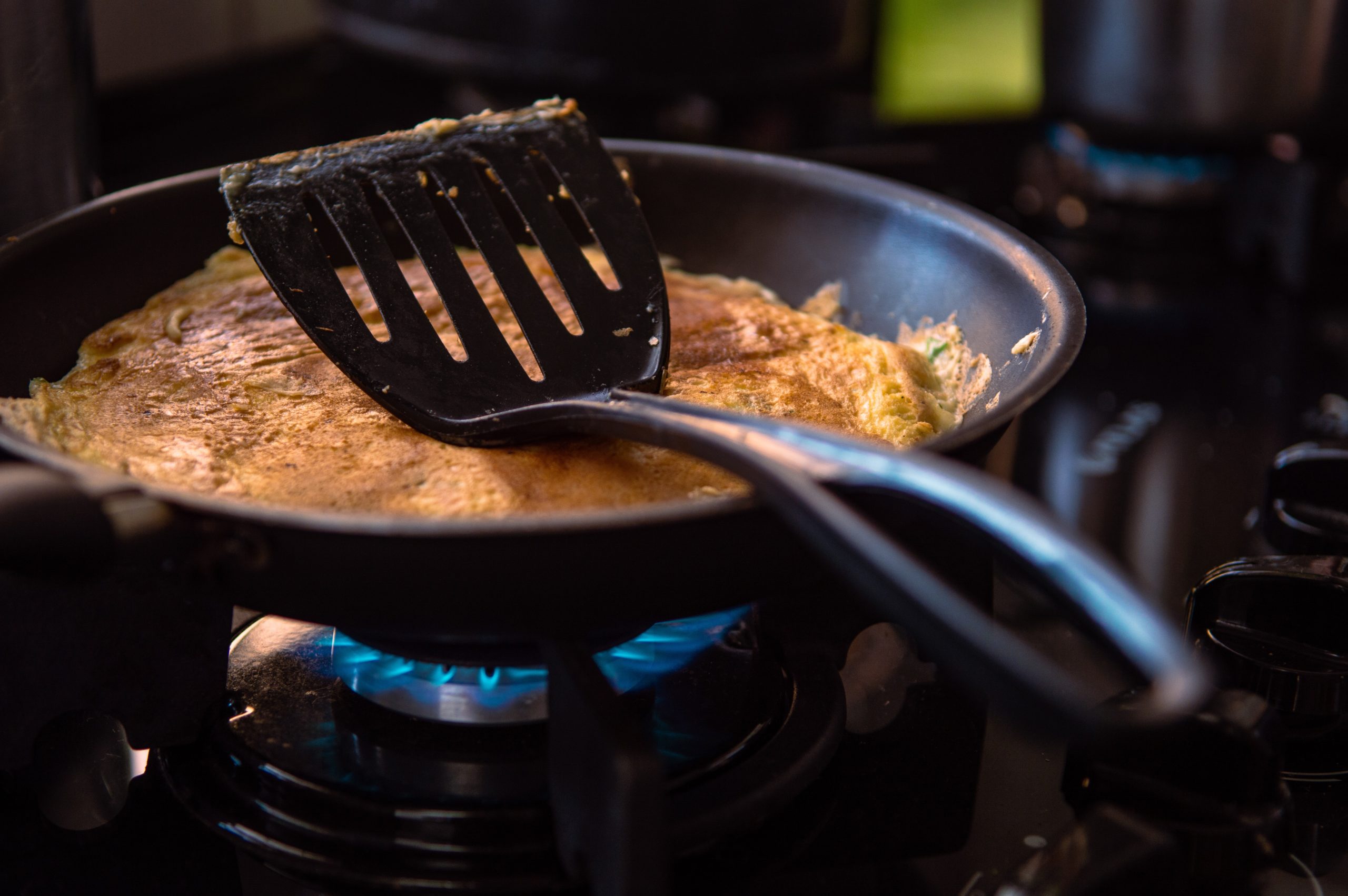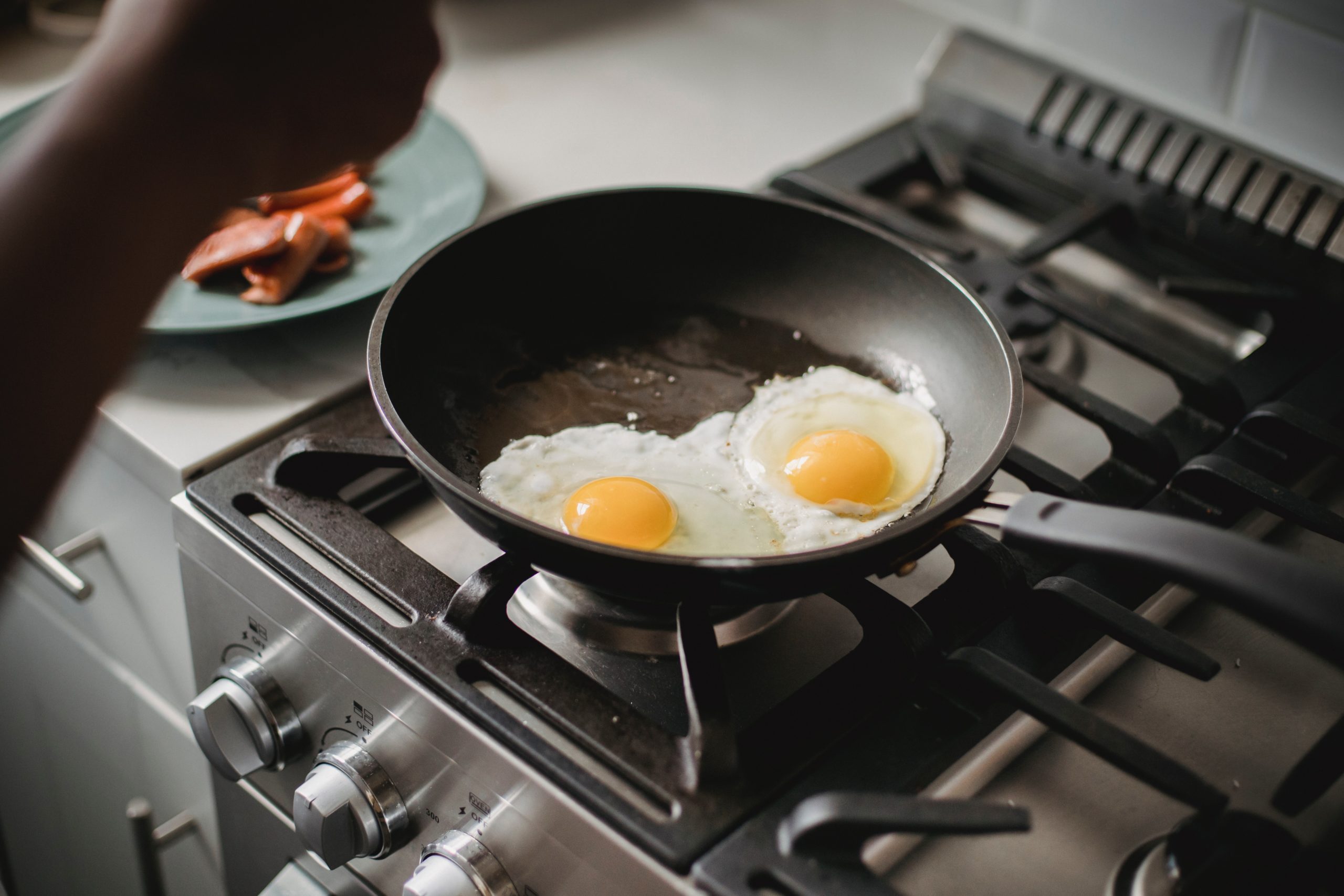A frying pan, often known as a skillet, is a flat-bottomed cooking pan commonly used for sautéing, frying, and browning food. Cast iron, stainless steel, aluminum, and nonstick-coated materials are among the materials used to make frying pans. The pan’s high sides allow for easy tossing and flipping of food, making it excellent for cooking everything from scrambled eggs to stir-fry.
A frying pan is an essential kitchen item because of its versatility and durability. It may be used for both everyday cooking and more complex techniques.
How to Fry in a Frying Pan?
A frying pan is a flat-bottomed skillet with long handles and low, flared edges ranging from eight to twelve inches. Stainless steel and aluminum are the most common materials used to make modern fry pans; however, cast iron and copper can also be utilized. This is how you use a frying pan:
- Heat the pan: Melt the butter in a frying pan over medium-high heat.
- Add oil: Pour in enough oil to coat the bottom of the pan, plus a little extra for good measure.
- Test the heat: Sprinkling a drop of water into the pan will test the heat of the oil. The pan is hot enough if it sizzles.
- Add food: Place the food in the pan gently, being careful not to overcrowd it.
- Fry: Fry the food until golden brown and cooked through, tossing regularly.
- Drain: Remove the food from the pan with a slotted spatula and set it on paper towels to absorb any residual oil.
- Serve: Serve immediately while still warm.
What are the Benefits of Cooking with a Frying Pan?
Here are several advantages to utilizing a frying pan:
- Versatility: A frying pan can be used for a number of culinary methods, including sautéing, browning, and searing.
- Easy to use: Frying pans are simple to operate and do not necessitate any special skills or knowledge.
- Fast cooking: Food may be swiftly cooked in a frying pan, making it a great option for busy weeknights.
- Browning: A frying pan’s high heat generates a lovely caramelized crust on food, adding flavor and texture.
- Brown sauce: By deglazing the pan with liquid after cooking, a frying pan can be used to make sauces such as pan gravies.
- Fewer dishes: You may prepare and serve food in the same pan using a frying pan, minimizing the number of dishes you need to wash.
- Economical: Frying pans are often less expensive than other types of cookware and are available at a variety of price points.
What are the Drawbacks of Using a Frying Pan?
Some of the disadvantages of using a frying pan are as follows:
- Messy: Oil splatters, and food sticks to the pan when frying.
- Oil absorption: Foods that have been fried in a skillet might absorb oil, making them harmful.
- Hot spots: Hot spots in frying pans occur when certain regions of the pan get hotter than others, resulting in uneven cooking.
- Stickiness: Food might stick to the pan if it is not cooked at the optimum temperature or if the pan is not properly seasoned.
- Limited size: Frying pans are typically small in size, making it difficult to cook large quantities of food at once.
- Maintenance: Cleaning and oiling frying pans on a regular basis are required to prevent food from sticking and to maintain their nonstick characteristics.
- Concerns about health: The high temperatures required for frying might cause toxic substances to leak into the food, creating possible health problems.
Can Eggs be Cooked in a Frying Pan?
Eggs can be readily cooked in a frying pan. On a frying pan, eggs can be cooked in a variety of ways, including fried, scrambled, poached, or as an omelet. A frying pan’s high heat is great for swiftly and evenly cooking eggs. Here’s how to cook eggs in a skillet:
- Preheat the pan: Melt the butter in a nonstick frying pan over medium heat.
- Add oil or butter: Add a tiny bit of oil or butter: Add a small amount of oil or butter to the pan.
- Crack the eggs: Crack the eggs into the pan, making sure they are equally spaced.
- Season: Season with salt and pepper on top of the eggs.
- Fry: Fry the eggs, flipping once until the whites are set, and the yolks are done to your liking.
- Serve: Serve the eggs right away with toast or another side dish, if desired.
Can you Cook Vegetables in a Frying Pan?
A frying pan is a multi-purpose cooking equipment that can be used to sauté, stir-fry, or roast vegetables. In a frying pan, vegetables such as peppers, onions, mushrooms, and greens may be rapidly prepared, making them a practical and healthful option for meals. Simply heat the skillet, drizzle with oil, and cook the vegetables until soft and caramelized. Season to taste with salt and pepper and serve hot. Here’s how to cook vegetables in a skillet:
- Select your vegetables: Choose your preferred vegetables, such as peppers, onions, mushrooms, and greens.
- Prep the vegetables: Prepare the vegetables by washing and chopping them into bite-sized pieces.
- Preheat the pan: Melt the butter in a nonstick frying pan over medium heat.
- Add oil: Pour a small amount of oil into the pan.
- Simmer the veggies: Place the cooked vegetables in the pan and cook, turning periodically, until soft and caramelized.
- Season: Season to taste with salt and pepper.
Cooked veggies can be served hot as a side dish or as a topping for a salad, grain bowl, or sandwich.
Can you Make Sandwiches in a Skillet?
Sandwiches like grilled cheese, paninis, and BLTs may be cooked quickly in a frying pan, making it an ideal alternative for a quick supper. A frying pan’s high heat can melt the cheese and crisp the bread, resulting in a warm, delectable sandwich. Simply heat the pan, add a small quantity of oil or butter, toast the bread and melt the cheese. Here’s how to make sandwiches in a skillet:
- Make the sandwich: Assemble your sandwich with the components of your choice, such as cheese, meat, vegetables, and condiments.
- Preheat the pan: Melt the butter in a nonstick frying pan over medium heat.
- Add a tiny bit of oil or butter: Add a small amount of oil or butter to the pan.
- Cook the sandwich: Place the sandwich in the pan and cook, flipping once, until the bread is toasted and the cheese is melted.
- Serve: Serve the heated sandwich right away.
Note: For paninis, a panini press or a heavy skillet can be used to press the sandwich and get a crispy, grilled texture.
What is the Proper Deep-Frying Technique?
Here are some proper deep-frying techniques:
- Use the proper oil: Choose a high-smoke-point oil, such as vegetable, canola, or peanut oil.
- Temperature control: Keep the oil at 375°F at all times to ensure that the food cooks evenly and does not absorb too much oil.
- Safety: Use a deep saucepan or a deep fryer with a basket and a lid for safety. Do not overfill the pan, and delicately lower the food into the oil using tongs or a slotted spoon.
- Drain: Using a slotted spoon or tongs, take the food from the oil and drain it on a paper towel-lined plate to remove excess oil.
- Season: Season soon after taking the meal from the oil to increase the flavor.
- Repeat: Repeat for subsequent batches of food, allowing the oil to recover to the right temperature between batches.
After deep-frying, filter the oil and keep it in a cold, dry place for future use. Reuse oil that has a burnt odor or has darkened in color.
How do you Clean a Pan Properly?
To avoid warping or damage, allow the pan to cool completely before cleaning. Soak the pan for a few minutes in warm, soapy water to release any stuck-on food. Scrub the pan’s surface lightly with a non-abrasive scrubber or sponge to remove any leftover food residue. To avoid rust, thoroughly rinse the pan with warm water to remove any soap residue, then dry it well with a soft cloth or paper towel.
To remove stubborn stains or stuck-on food, make a paste with baking soda and vinegar, apply it to the afflicted area, and let it sit for a few minutes before washing and rinsing. Steel wool and abrasive sponges should be avoided as they can harm the pan’s surface.
Conclusion
A frying pan is a flexible kitchen item that may be used to prepare a wide range of foods, such as eggs, veggies, sandwiches, and more. When cooking using a frying pan, it’s critical to apply suitable techniques, such as preheating the pan and adding the appropriate amount of oil or butter, to ensure that the food cooks evenly and doesn’t stick. Allowing the pan to cool before immersing it in warm soapy water and completely drying it will assist in maintaining its quality and extend its lifespan. A frying pan is a must-have in any kitchen, whether you’re an expert cook or a newbie.

